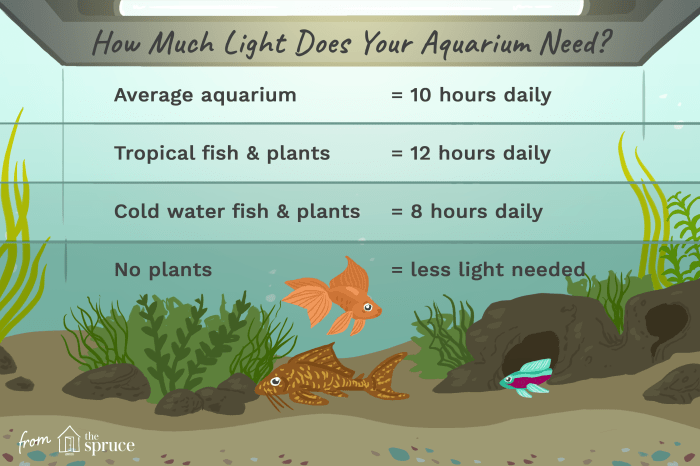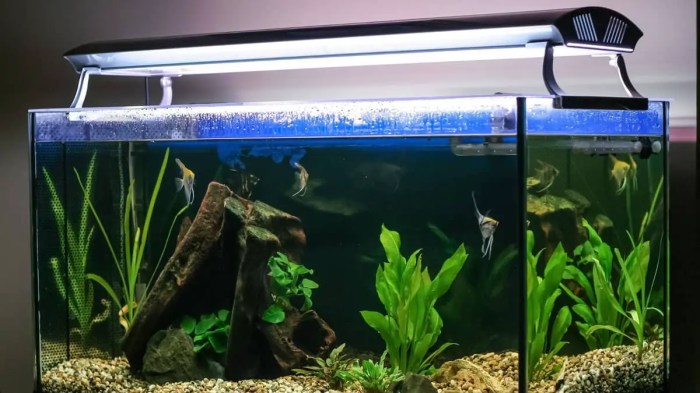How much light do aquarium plants need? It’s a question every aquarist grapples with, and the answer is more complex than you might think. Just like plants on land, aquatic plants require sunlight for photosynthesis, the process that converts light energy into usable energy for growth.
But underwater, light intensity and spectrum are drastically different, and understanding these nuances is crucial for cultivating a thriving underwater garden.
This guide will explore the vital role of light in aquarium plant health, delving into the science behind photosynthesis, the different types of aquarium lighting, and how to measure light intensity. We’ll also discuss the factors influencing light needs, including plant species, tank size, and water depth.
By the end, you’ll have the knowledge to create the perfect lighting conditions for your aquarium plants, fostering a vibrant and healthy ecosystem.
Measuring Light Intensity

Understanding the amount of light your aquarium plants receive is crucial for their health and growth. Just like humans need the right amount of sunlight, aquarium plants require specific light levels to thrive. This section will guide you through the process of measuring light intensity and its importance in plant growth.
Units of Light Measurement
Light intensity is measured in different units, each representing a specific aspect of light. Here are the most common units used in aquariums:
- Photosynthetically Active Radiation (PAR):PAR measures the light wavelengths (400-700 nanometers) that plants use for photosynthesis. It’s often expressed in micromoles per square meter per second (µmol/m 2/s). PAR is considered the most accurate measure of light intensity for plant growth.
- Lumens:Lumens measure the total amount of light emitted by a light source, regardless of its wavelength. This unit is commonly used for general lighting, but it’s not as specific for plant growth as PAR.
- Lux:Lux measures the illuminance, or the amount of light falling on a surface. It’s also not as accurate as PAR for plant growth, as it doesn’t differentiate between wavelengths.
Relationship Between Light Intensity and Plant Growth
Light intensity directly impacts plant growth by influencing the rate of photosynthesis. Plants use light energy to convert carbon dioxide and water into sugars, which provide them with energy for growth and development.
Higher light intensity generally leads to faster growth, as plants can produce more sugars through photosynthesis. However, excessive light can also cause stress and damage to plants.
- Low Light:Plants adapted to low light environments may grow slowly, with smaller leaves and less vibrant colors. They may also struggle to compete with algae for nutrients.
- Medium Light:This is the optimal range for most aquarium plants, allowing them to grow at a healthy rate with vibrant colors and good overall health.
- High Light:While high light can promote rapid growth, it can also lead to algae blooms and stress on plants if they are not acclimated properly.
Tips for Measuring Light Intensity
There are several ways to measure light intensity in your aquarium. Here are some tips:
- PAR Meters:These are the most accurate and reliable way to measure light intensity. PAR meters measure the light in the photosynthetically active range, providing the most relevant information for plant growth.
- Smartphone Apps:Some smartphone apps can measure light intensity using the phone’s camera. While these apps are not as accurate as PAR meters, they can provide a general idea of light levels.
- Light Fixture Information:Check the specifications of your aquarium light fixture. They often provide information about the light output in lumens or lux. This information can be used as a starting point, but it’s important to verify with a PAR meter for accuracy.
Factors Influencing Light Needs

Determining the appropriate light levels for your aquarium plants is not a one-size-fits-all approach. Several factors interact to influence the specific light requirements of your plant community. Understanding these factors will help you create an environment where your plants can thrive.
Plant Species
Different plant species have varying light requirements. Some plants are adapted to low-light conditions and can flourish in dimly lit tanks. Others, however, are considered “high-light” plants and need intense lighting to grow optimally. Knowing the specific light needs of your chosen plant species is crucial for their successful cultivation.
- Low-Light Plants:These plants can survive and even thrive in low-light conditions, typically under 1 watt per gallon (WPG). Examples include Java Fern, Anubias, and Cryptocoryne.
- Medium-Light Plants:These plants require moderate lighting, usually between 1 and 2 WPG. Popular examples include Amazon Sword, Water Wisteria, and Vallisneria.
- High-Light Plants:High-light plants need intense lighting, often exceeding 2 WPG. They include demanding species like Red Ludwigia, Hygrophyla, and Rotala.
Water Depth, How much light do aquarium plants need
Water depth plays a significant role in light penetration. As light travels through water, it gradually weakens. Deeper water absorbs more light, resulting in less light reaching the plants at the bottom. This means that plants in deeper tanks may need stronger lighting to compensate for the reduced light intensity.
For every 12 inches of water depth, light intensity is reduced by approximately 50%.
For example, a plant at the bottom of a 24-inch deep tank will receive only 25% of the light intensity compared to a plant at the surface. Therefore, a deeper tank may require higher wattage lighting to ensure adequate light reaches all plants.
Tank Size and Plant Density
The size of your aquarium and the density of plants also influence light needs. A larger tank with fewer plants requires less lighting than a smaller tank with densely packed plants. This is because light can penetrate more easily through a less crowded environment.
Just like goldfish need a balanced diet, aquarium plants thrive with the right amount of light. Too little, and they’ll struggle to photosynthesize. Too much, and they can be prone to algae growth. While you’re considering your aquarium’s needs, you might also wonder about feeding your goldfish a healthy diet.
Check out Can Goldfish Eat Carrots: A Guide to Safe Veggie Treats to learn about adding carrots to your goldfish’s menu. Just remember, providing the right amount of light for your aquarium plants is essential for a thriving ecosystem, and that includes the health of your goldfish.
- Smaller tankswith high plant density may need higher light levels to ensure all plants receive adequate light.
- Larger tankswith lower plant density can typically thrive with lower light levels.
Light Spectrum and Plant Growth
Plants use light energy to carry out photosynthesis, the process of converting light energy into chemical energy. Different wavelengths of light have varying effects on plant growth, impacting processes like chlorophyll production, stem elongation, and flower development. Understanding the light spectrum is crucial for providing aquarium plants with the optimal conditions for thriving.
Photosynthetically Active Radiation (PAR)
The portion of the electromagnetic spectrum that plants utilize for photosynthesis is known as photosynthetically active radiation (PAR). This range encompasses wavelengths between 400 and 700 nanometers (nm), corresponding to the visible light spectrum. PAR is measured in micromoles per square meter per second (µmol/m²/s).
PAR is a critical factor in determining the light intensity required for plant growth.
The Impact of Different Wavelengths on Plant Growth
- Blue Light (400-500 nm):Blue light is essential for chlorophyll production and stem elongation. It promotes compact growth and healthy leaf development.
- Green Light (500-550 nm):Plants reflect green light, which is why they appear green. While not directly used for photosynthesis, green light can still contribute to plant growth by influencing the production of other pigments and regulating stem elongation.
- Red Light (600-700 nm):Red light plays a crucial role in flowering and fruiting. It stimulates stem elongation and promotes the production of carbohydrates.
- Far-Red Light (700-800 nm):Far-red light is involved in photomorphogenesis, the process of plant development in response to light. It can influence stem elongation and leaf expansion.
Ideal Light Spectrum for Aquarium Plants
| Plant Type | Blue Light (400-500 nm) | Red Light (600-700 nm) | Far-Red Light (700-800 nm) |
|---|---|---|---|
| Low-Light Plants | Low | Low | Low |
| Medium-Light Plants | Moderate | Moderate | Moderate |
| High-Light Plants | High | High | Low |
Light Cycles and Plant Health
Just like humans, aquarium plants need a regular sleep-wake cycle to thrive. A consistent light cycle mimics the natural rhythm of day and night, signaling to plants when to photosynthesize and when to rest. This helps them grow strong, healthy, and vibrant.
Optimal Light Duration
The ideal light duration varies depending on the plant species. Some plants, like Anubias and Java Ferns, are low-light plants and can thrive with only a few hours of light per day. Others, like Amazon Swords and Red Ludwigia, require more light to flourish.
- Low-light plants:4-6 hours of light per day
- Medium-light plants:6-8 hours of light per day
- High-light plants:8-10 hours of light per day
It’s important to research the specific light requirements of the plants you choose for your aquarium. Overexposure to light can lead to algae growth and stress for your plants, while insufficient light can result in stunted growth and pale coloration.
Creating a Natural Light Cycle
To mimic a natural light cycle, use a timer to control your aquarium lights. This will ensure a consistent schedule for your plants, promoting healthy growth and preventing stress.
- Set a timer:Choose a timer that allows you to program a specific on/off schedule. For example, you can set the lights to turn on at 8:00 AM and turn off at 8:00 PM, simulating a 12-hour day.
- Avoid sudden changes:Gradual changes in light duration are better than abrupt shifts. If you need to adjust the light cycle, do so slowly over a few days to allow your plants to adapt.
- Consider the seasons:You can adjust the light cycle slightly to mimic the natural changes in daylight hours throughout the year. For example, you might extend the light duration in the summer months and shorten it in the winter months.
Summary: How Much Light Do Aquarium Plants Need
Creating the ideal lighting environment for your aquarium plants is a journey, not a destination. It requires careful consideration of plant species, tank size, and water conditions. By understanding the science behind light and its impact on aquatic plant growth, you can unlock the potential for vibrant, healthy, and thriving underwater gardens.
Remember, just like any living organism, plants need the right amount of light to flourish. With a little research and attention to detail, you can create a beautiful and sustainable aquatic ecosystem that will bring you joy for years to come.